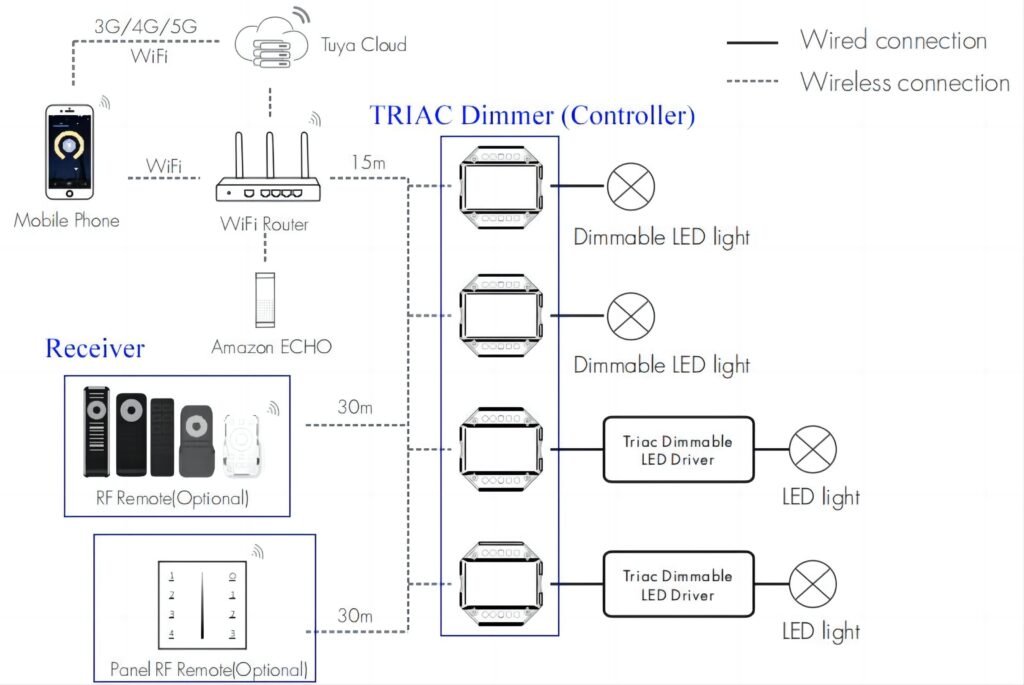Have you ever wondered how your dimmable LED lights adjust to the perfect ambiance with just a simple slide or turn of a switch? Welcome to my world of lighting magic, where dimming isn’t just about setting the mood; it’s an art and a science. As a seasoned expert in the LED lighting industry, I’ve navigated through the nuances of various dimming technologies, and today, I’m here to illuminate your understanding of TRIAC dimmers.
TRIAC dimmers are the unsung heroes behind your seamless lighting adjustments. They are pivotal in creating the right atmosphere, whether it’s for a cozy dinner or focusing on your work.
Understanding different dimming technologies is crucial, not just for lighting designers but for anyone keen on optimizing their lighting solutions. So, let’s dive deep into the world of TRIAC dimming, comparing it with other technologies like 0-10V, DALI, PWM, and DMX512, ensuring you make an informed decision for your lighting needs.
What is a TRIAC Dimmer?
A TRIAC (Triode for Alternating Current) dimmer is essentially a switch that controls the intensity of light. It works by varying the amount of power delivered to a light source, allowing for smooth transitions between brightness levels. This technology is widely embraced in residential and commercial settings for its compatibility with incandescent and LED lights.

The beauty of TRIAC dimming lies in its simplicity and effectiveness. It’s a tried-and-tested technology that has been lighting up our spaces for decades, offering a straightforward solution for adjustable lighting.
How Does a TRIAC Dimmer Work?
Diving into the technicalities, a TRIAC dimmer modulates the power flow to the lamp by cutting off parts of the AC waveform. This phase-cut method is what allows the dimmer to adjust the light output, leading to the dimming effect we all enjoy. It’s like having a volume control for your lights, where you get to decide the intensity.

Understanding the operation of TRIAC dimmers is essential for anyone involved in lighting design or installation. It ensures you can make the most out of your lighting fixtures while maintaining efficiency and longevity.
Comparing Dimming Technologies: TRIAC, 0-10V, DALI, PWM, and DMX512
When it comes to dimming, one size does not fit all. Each technology—TRIAC, 0-10V, DALI, PWM, and DMX512—has its unique characteristics, advantages, and ideal applications. Knowing these differences is key to selecting the perfect dimming solution for your project.

Let’s explore these technologies, highlighting their distinctions to help you navigate through your options.
TRIAC vs. 0-10V Dimming
TRIAC dimming and 0-10V dimming are both popular choices, but they cater to different needs. While TRIAC is great for residential use, 0-10V is often favored in commercial environments where precise control over lighting is required. The main difference lies in their control mechanism and compatibility with various light sources.
Choosing between TRIAC and 0-10V dimming depends on your specific lighting requirements, including the type of fixtures, desired ambiance, and control flexibility.
TRIAC vs. DALI Dimming
Comparing TRIAC with DALI (Digitally Addressable Lighting Interface) brings us to the realm of smart lighting. DALI offers sophisticated control, including individual light adjustment, system integration, and feedback capabilities, unlike the more straightforward TRIAC dimmers.
For environments where lighting plays a critical role in ambiance, functionality, and energy efficiency, understanding the advantages of each system is crucial. DALI might be your go-to for advanced control, but TRIAC holds its ground for simplicity and reliability.
TRIAC vs. PWM Dimming
Now, let’s talk about PWM (Pulse Width Modulation). This technology differs from TRIAC by controlling the light output through the duration of the electrical pulses, providing a constant voltage to the light source. It’s particularly useful in scenarios where color stability and dimming range are paramount.
The choice between TRIAC and PWM often boils down to the specific requirements of your lighting application, especially in terms of flicker, efficiency, and control precision.
TRIAC vs. DMX512 Dimming
Lastly, DMX512 stands out as a protocol primarily used in theatrical and entertainment lighting, offering a high level of control over complex lighting systems. It’s a robust system designed for dynamic lighting effects, contrasting with the more static TRIAC dimming.
Understanding when to use DMX512 over TRIAC is essential for projects that require intricate lighting scenes or where lighting is part of the performance, not just illumination.
Practical Tips for Choosing the Right Dimming Technology
Choosing the right dimming technology is more than just understanding technical specifications; it’s about aligning those specs with your project’s needs. Consider factors like compatibility, control requirements, installation environment, and budget. Drawing from my decade-long experience in the LED lighting industry, I recommend consulting with a lighting expert to tailor the best dimming solution for your space.
Conclusion
As you consider your next lighting project, I encourage you to delve deep into the characteristics of these dimming technologies. Evaluate your space’s requirements, consider the ambiance you wish to create, and don’t hesitate to experiment with different solutions to discover what works best for your unique situation. Remember, the right dimming technology can elevate a space from ordinary to extraordinary, enhancing both its aesthetics and functionality.
Embarking on the exploration of TRIAC dimmers opens a gateway to enhanced lighting control, marrying simplicity with functionality. My decade-long journey with Lowcarbon has reinforced the value of selecting the right dimming technology to not only meet aesthetic and practical needs but also to ensure energy efficiency and user satisfaction. While TRIAC dimmers stand out for their reliability and ease of use, understanding the nuances of other technologies like 0-10V, DALI, PWM, and DMX512 is crucial for tailored lighting solutions. As you navigate your lighting projects, remember that the right dimmer can transform a space, marrying form with function, and turning ordinary environments into remarkable experiences. Choose wisely, illuminate boldly, and let your spaces shine with the optimal dimming solution.
